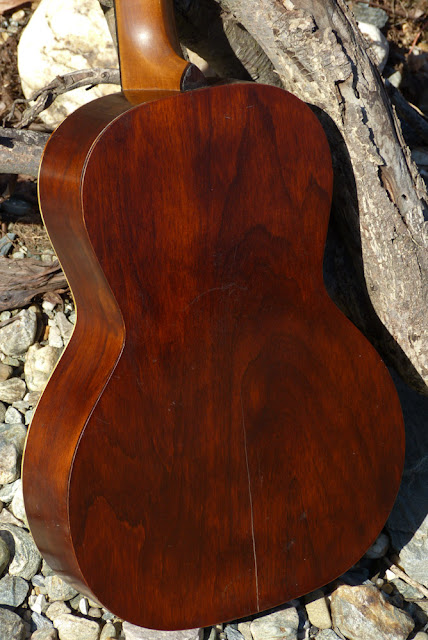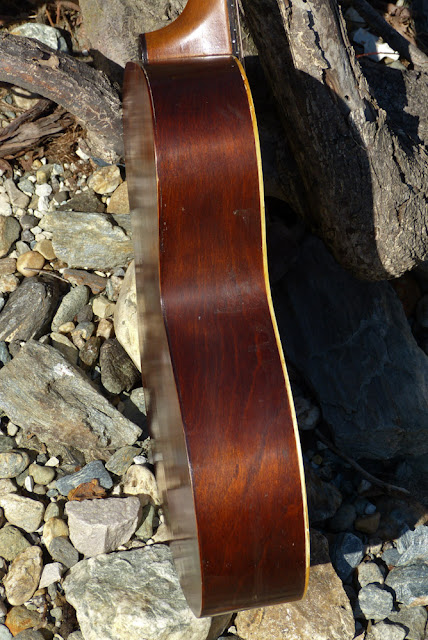1920s Stromberg-Voisinet Parlor Guitar
I received this guitar in trade a while back and have been tinkering with it over time. It's now received a neck reset, brace and seam repairs, hairline crack repairs to a longer one on the back and to several shorter ones on the front, a fretboard reglue and fret level/dress, new bone nut and saddle, new bridge, and a good setup. It's a great fingerpicker and has a surprisingly-full sound for that use, though flatpicked with a somewhat flexible nylon-style pick it sounds nice and "old timey" as well.
I've worked on a lot of similar Chicago-made Kay/Stromberg-Voisinet (same company) guitars of this stripe over time, and while this guitar is more-or-less original, its top has been at the very minimum sloppily "finished over" or "refinished" as it originally had deco-style decals applied to it. Still, the nicely-grained spruce top isn't protesting too much in the looks department and it has a sort of "rustic" charm in its yellowed-amber look.
I forgot to take a good picture of this detail, but there's some "chewed up" binding and missing purfling on the lower bout at the very bottom that you can see if you "blow this above pic up."
There are also 5 or 6 hairline cracks with 4" length or so. I've cleated where necessary and drop-filled/sealed them. They're good to go.
The guitar is "standard issue" at the time with a 13" lower bout.
This has a 1 3/4" nut width and medium V-shaped neck profile, though the string spacing is a little closer to what you'd find on a 1 11/16" nut width to match-up with my replacement bridge's spacing better. I actually find this a bit more comfortable for chording than the usual (hair wider) spacing, personally.
The nut is new... and bone. The Kay-style "Gumby" headstock is only half-slotted and has a solid rear to it. It's a neat feature on these.
The board is dyed/stained maple and the original frets have plenty of life but are of that vintage small, narrow type which won't make someone who presses hard into them on slides happy. If you have a light touch -- no worries, you'll glide right over them.
Note the added side dots.
If you noticed the very slight paper-thin "ledge" next to the fretboard -- it's not because binding is missing (too thin), it's because the maple boards shrink slightly over time.
Check out the nice marquetry-style purfling and white celluloid binding, though.
This is a new-old-stock late-50s Gibson bridge and, yes, it's Brazilian rosewood. I added pearl dots, a new compensated bone saddle, and ebony pins all-around.
Action is spot-on at 3/32" EA and 1/16" DGBE at the 12th fret and it's strung with 50w, 38w, 28w, 20w, 16, 12 "balanced tension" custom lights. The scale length is 24 1/4" and so the tension and feel is slinky.
The back and sides are solid birch and the neck is poplar.
You can see that some of the back seams have a bit of old repair muckiness about them (not ugly but obvious that it was glued). There is, however, also some obvious "varnish dripping" from off the top and onto the sides near the neck joint.
The back crack is repaired and steady.
A trapeze tailpiece was installed at some point. Also note the new ebony endpin.



















Comments